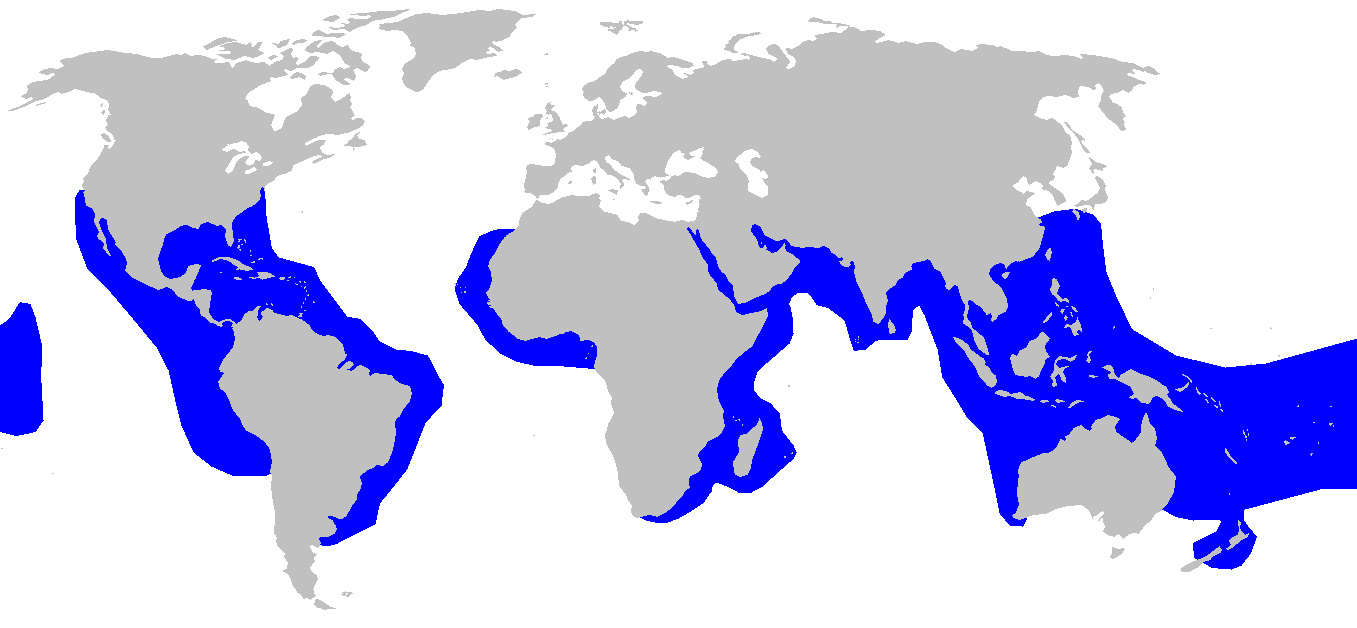
Animal description
The Tiger Shark (Galeocerdo cuvier), often recognized for its distinctive dark stripes reminiscent of a tiger's pattern on its blue to greenish-gray body, is one of the ocean's most fascinating and formidable predators. This species, named for its unique markings that fade as the shark ages, is second only to the Great White Shark in terms of reported attacks on humans, though it remains less aggressive and less likely to encounter people.Found in many tropical and temperate waters worldwide, particularly around central Pacific islands, this solitary nocturnal hunter has adapted remarkably to its environment. Its habitat spans from river mouths and shallow bays to open ocean waters, demonstrating the species' impressive versatility.
One of the most striking features of the Tiger Shark is its size. Adult Tiger Sharks can reach lengths of up to 14 to 18 feet (4.3 to 5.5 meters) and weigh between 850 to 1,400 pounds (385 to 635 kilograms), making them one of the largest shark species in the ocean. Their robust and streamlined bodies enable them to swim swiftly and with great agility, an essential trait for a top predator.
The diet of the Tiger Shark is as varied as its habitat, earning it the nickname "the wastebasket of the sea." These sharks are notorious for their undiscriminating palate, consuming everything from fish, crustaceans, and mollusks, to dolphins, sea turtles, and seabirds. They have even been found with inedible manmade objects in their stomachs. This opportunistic feeding behavior is facilitated by their highly developed senses, including acute hearing, smell, and a unique sensory organ called the lateral line, which detects vibrations in the water.
The Tiger Shark's teeth are another fascinating aspect of its anatomy. Unlike most other sharks, its teeth are unique in that they are notched on both sides, resembling a circular saw. This design allows them to slice through the shells of sea turtles and other tough-skinned or shelled prey with ease.
Reproduction in Tiger Sharks is ovoviviparous, a method where eggs hatch inside the female's body, and the young are born live. Females give birth to litters of 10 to 80 pups after a gestation period of about 13 to 16 months. These young sharks are born fully formed and are independent from birth, receiving no parental care.
Despite their prowess as apex predators, Tiger Sharks face threats from human activities, including targeted fishing for their fins, skin, and liver, as well as unintentional capture in fishing gear. While they are currently listed as Near Threatened by the International Union for Conservation of Nature (IUCN), their populations are believed to be declining.
The Tiger Shark plays a critical role in marine ecosystems, helping to maintain the balance of marine life by preying on the weak and sick. Their presence indicates a healthy, biodiverse habitat. Conservation efforts and further research are essential to ensure the survival of this magnificent species, allowing it to continue its role in the ocean's complex food web.
Map of occurrence

Similar Animals
New photos of animals
Top 10 animals
- Dolphin gull (Leucophaeus scoresbii)
- Diana monkey (Cercopithecus diana)
- Moustached guenon (Cercopithecus cephus)
- Galápagos tortoise (Geochelone nigra complex)
- Stone loach (Barbatula barbatula)
- Japanese macaque (Macaca fuscata)
- Greek tortoise (Testudo graeca)
- Russian tortoise (Testudo horsfieldii)
- Common flying dragon (Draco volans)
- Galápagos penguin (Spheniscus mendiculus)


